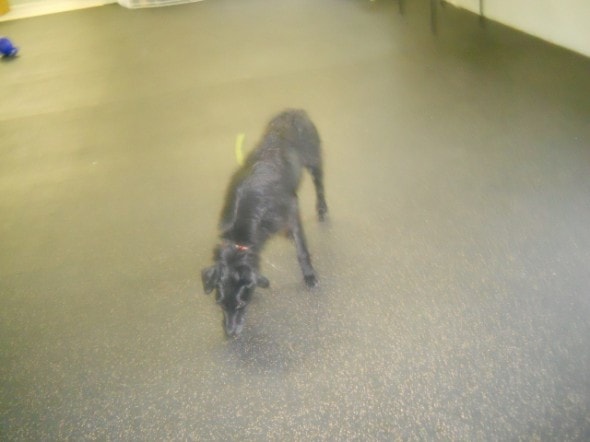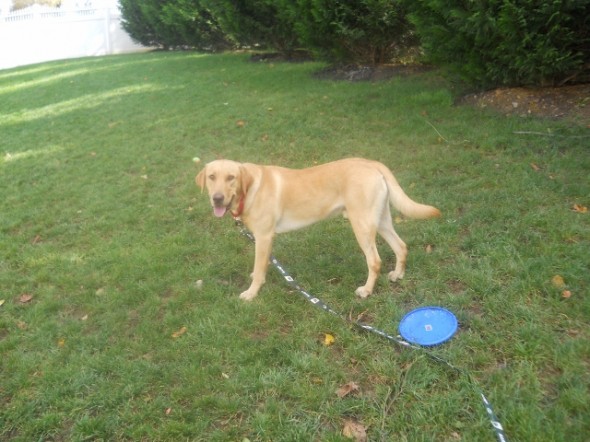Winter: a distant thought on this brilliant fall day in Maryland. Indeed I cringe at the thought of icy roads. Snow (being a staunch Canadian) is OK but ice? Treacherous. Have you ever been helpless and stuck at the bottom of an icy incline? How can something so close be so far away? Gaining an inch of traction towards the summit is a nerve wracking ordeal. Sometimes you need to back up a little bit, go in reverse, to gain that forward momentum.
As I often explain to clients, reaching a distant long term goal necessitates a similar approach. With fearful dogs, we must sometimes go “a little bit backwards” in order to gain traction and forward momentum. How we ache to reach hug love and stroke, but respecting the space of a fearful dog, waiting for them to nudge that hand and solicit attention is the way to go. Yes, we feel desperate to stroke the silky fur and “make it all better.” It seems like the right thing to do, but these dogs need time and space, not crowding. Allow these concerned canines find their way and progress will be so much faster.

As humans, with our impatient ways, we put the pedal to the medal, damn the torpedoes, in full steam ahead mode. We have little tolerance for the slippery slopes impeding our forward progress. Flooring it on those icy hills often means skidding out of control. Similarly, forcing attention on a fragile being acclimating to a strange land, though well meaning, increases stress. Ease off on the pedal of progress and simply let the dog learn to “be” in this new environment. As Suzanne Clothier says “always ask the dog.” Dog body language never lies. They will tell you when it is not OK.
Keep in mind that your fearful dog may:
- Have an unknown background.
- Be woefully under-socialized.
- Lack trust in new humans.
- Not feel safe in the new environment.
- Lack domestic house hold experience.
- Have existed as a stray or shelter dog, with much accumulated stress.
- Be showing behaviors that are based in fear.
- Feel worse and/or attempt to bite when put in high stress situations, such as forced interactions with strange humans.
I take great pleasure in introducing a friend who has likewise rehabbed a puppy mill dog. Recently I had the pleasure of meeting impressively credentialed face book pal Rise VanFleet Ph.D at the APDT Conference. Rise does important CAPT (Canine-Assisted Play Therapy) work with Playful Pooch. Follow along as Rise compellingly details her compassionate respectful and effective approach to a near wild animal, the ongoing story of Zoom Zoom Zoom aka Katie.
Recently, fearful Jett came into my life, via Lab Rescue of the Greater Potomac and his adopting family. Lovely sweet Jett needed a similar approach as he learned to live in a new world, a strange land. Sudden movements sent him scurrying for refuge. A standing human reaching out? Intolerable. With appropriate dog-human interactions and body language, Jett is gaining traction in his new world and making strides in recovery.

Some basic pointers for new rescues:
- Hold off on the family reunion, trips to doggy parks and hiking around the block until you have a sense of who they are.
- Give them their own space to just “be” in a low travel quiet room of the house with a cozy open crate, soothing music and good smells.
- Use meals as an interactive time, to begin establishing trust. Sit/lay on the floor at a distance that is tolerable, and toss food away from you. Begin feeding from a passive hand when your dog can approach willingly.
- Use appropriate body language. Sitting is better than standing. Sideways is better than full frontal. Never loom and reach overhead. Educate all who will interact.
- That they need food to survive is often the only thing working for a fearful dog. Pair every human interaction with food wonderful food.
- If you are not prepared to deal with the incremental progress often required do consult with a positive dog training professional for guidance. Doing the wrong things, even well meaningly, can spell disaster.
Is there is a fearful dog in your life? Recognize that “a litle bit backwards” means the world to this dog. Backing off and just allowing this dog to “be” on his terms will allow him the necessary traction to start moving forward on the slippery slope of his new life. He will gain trust in the clever humans who sit back, observe, and allow the fearful fellow to approach on his own terms, without restraint hurry or expectations.
Good luck navigating the slippery slopes of winter driving and life in general.Until next Friday,
Leslie Fisher PMCT CPDT-KA and the labbies, Bridget Talley and Doobie
“you pet positively trained” Rainwood Kennel Elkton MD
